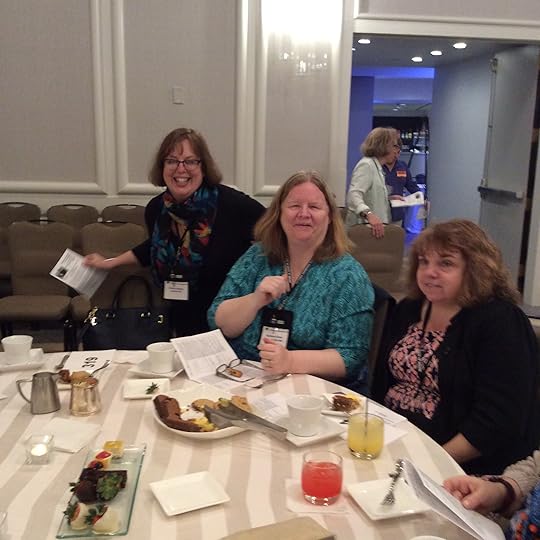Lea Wait's Blog, page 261
May 10, 2016
MAY FAVORITES NO MYSTERY
Susan Vaughan here. My dog Sasha insists on taking me for walks along our lane and on the woods path, showing me all the new growth and returning birds. So here are my faves, as we stroll along…
Dogtooth violets carpet the woods more than usual this May. Before other low-growing plants take over, they’re a bright yellow (not violet) reminder the sun is in the sky for longer each day. I nearly tripped a few times admiring the expanse of color.
Purple trilliums dot the woods floor here and there among the dogtooth violets and in one spot have taken over. The flower is also called wake-robin and stinking Benjamin, not a flattering name for a pretty blossom, but up close you can’t miss the nasty scent.
Our woods are home to a pair of barred owls. This morning the two of them perched silently in adjacent trees along the lane, apparently blasé about the crows flapping around and complaining about their presence. I can’t wait to see the owlets, decked out in fluffy feathers and learning to hunt frogs in the small pond. Sasha, of course, paid no attention to the activity in the trees. She was as usual nose to the ground.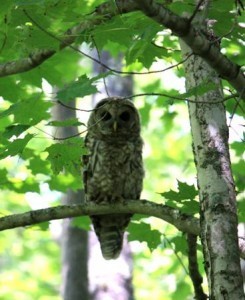
Many songbirds have returned north to our feeder to join the chickadees and nuthatches—goldfinches, house finches, and others I’d need to study a bird book to name. But the king—or queen—of the woods is a woodpecker. I laugh along whenever I hear the loud ha-ha-ha-ha-ha echo through the trees. The pileated woodpecker is the largest North American woodpecker, about crow size, but its red crest and long tail feathers make it appear larger. It was the model for Woody the Woodpecker.
Lastly, seeing my own shrubs and flowers bloom cheers me, especially after such a long, cold winter.That was it for this walk. Ready for a biscuit and a nap, Sasha led the way to the door.
*** A lucky May commenter will win a bag of Maine books. So come back often.
May 9, 2016
50 Shapes in Gray

Auntie Lisa and Piper admiring the big turtle.
John Clark sharing another great Maine resource with MCW readers. When my daughter Lisa who teaches in the Bronx and often comes to Maine when there’s a school vacation, put my granddaughter on the phone, Here’s what I heard. “Grandpa, will you come to see the beahs with me?”
Who can say no to that kind of request? Not I for sure. We headed to the Maine Wildlife Park in Gray. It’s located at 56 Game Farm Road, not far from the Maine Turnpike.
Beth and daughter Sara had brought Piper there once before and the beahs (her pronunciation), made a big impression. At a little over two (her birthday is March 3rd) Piper has Grandpa’s eye for spotting wildlife and loves new adventures. While we visited the day following the late April snowstorm, the accumulation was receding quickly, making it easy to propel her stroller.
Hours are as follows. Open daily 9:30 am – 4:30 p.m. Visitors may stay until 6:00 p.m. Admission varies. Children under age 3 are free, ages 4 -12 are $5.50, ages 13 – 59 are $7.50, ages 60+ are $5.50 and groups of 15 or more are $3.50 per person. Season passes are available.
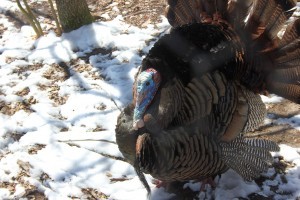
Wadda YOU lookin’ at?
We had full sunshine and almost no breeze during our three hour stroll around the park. In addition to the resident creatures, we were serenaded by at least two cardinals. We started with the bird enclosure where a very belligerent tom turkey gave us the hairy eyeball right under a sign warning visitors that ‘I bite.’ When I looked at the pen behind him which was separated by a wire fence, I could understand part of his frustration. Here he is with all this natural face paint and puffery, but not a hen in sight. What does he have as a neighbor? A cock pheasant with six hens to keep him happy. That kind of injustice would frustrate any guy. In addition to these, there are a bald and a golden eagle, a couple turkey vultures, a raven, several owls, peregrine falcons and a peacock.

Turkles is what we called them when I was Piper’s age.
Despite the chill (there was a skim of ice on the bog near the bears), as you can see from the accompanying picture, there are several types of turtles already active.
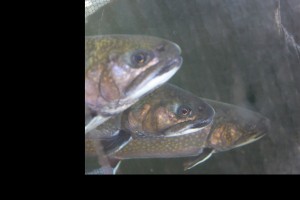
We know how awesome we are.
Next up was the fish hatchery that not only has a circular pool where at least a thousand 6-8” brook trout await freedom (however brief) in some nearby lake or stream, but a pretty fair number of mature brookies that live in a separate area and must give plenty of anglers pipe dreams as they swim slowly past the viewing area.
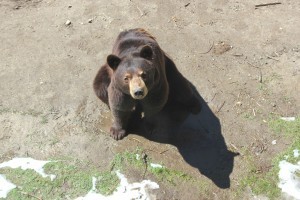
I don’t suppose you’re Christopher Robin by any chance?
Then it was on to the beahs and, while the darker of the two snoozed in a warm bed of mud, the lighter one was happy to milk the crowd for as much food as they were willing to buy with quarters. Not far from them resides a solitary coyote who never stopped pacing long enough for me to get a decent photo. The four moose nearby, had the opposite reaction. They remained lying down at the back of their fenced in area, content to snooze in the sun.
While not exactly native (it depends on who you ask), there is a mountain lion in residence with golden brown hair. Right next to him are a pair of Canada Lynx who are gray in color All three gave us a dismissive look and went back to sleep. Finding the two bobcats in their natural habitat across from them was a bit of a challenge, as they were cuddled together in a small depression. It wasn’t until their ears wiggled that we were able so spot them.
After a picnic lunch (there are plenty of benches and picnic tables available), we went to the last part of the trail where smaller animals and the resident deer herd reside. In addition to a porcupine, a fisher, an opossum and a skunk, there are two raccoons, one of which is albino, and a woodchuck who was still in hibernation. We counted six deer, one of which was also albino. There may have been more as they’re adept at blending in with the terrain.

I’m cooler than the fish.
In addition to all the animals, there is a visitor center where you can press feet, hooves and cl;aws into sand to see what fresh tracks look like, as well as read up on interesting facts about Maine wildlife and touch various hides and pelts. It’s a fine place for you to take friends and relatives from away as well as introduce the next generation to the part of Maine so many are getting away from. Here’s the website where you can find out more. http://www.maine.gov/ifw/education/wildlifepark/
May 8, 2016
Happy Reading
Dorothy Cannell: Had a marvelous time at the Malice convention in Bethesda; the  feeling is always one of attending a family reunion with only the lovable relatives present. This one was extra special because Katherine Hall Page received the Lifetime Achievement Award. So well deserved. Returned home to contend with the mystery of why it always takes five times as long to unpack as it does to pack for the trip. My husband Julian attests there is nothing to ponder in this regard, the blame goes to all the books that climbed unnoticed into our luggage. Not true! The problem is the clothes have married (or lived in sin) and produced offspring in celebration of being freed from the closet where they huddle most of the year living lives of quiet desperation.
feeling is always one of attending a family reunion with only the lovable relatives present. This one was extra special because Katherine Hall Page received the Lifetime Achievement Award. So well deserved. Returned home to contend with the mystery of why it always takes five times as long to unpack as it does to pack for the trip. My husband Julian attests there is nothing to ponder in this regard, the blame goes to all the books that climbed unnoticed into our luggage. Not true! The problem is the clothes have married (or lived in sin) and produced offspring in celebration of being freed from the closet where they huddle most of the year living lives of quiet desperation.
Okay, I protesteth too much. Within seconds of arrival at the hotel and registering I invariably make a beeline for the book room in search of out of print or hard to find books by mystery writers who weren’t Agatha Christie or Dorothy Sayers but were popular and admired during their time. My excuse for exercising this passion if that my current series is “period” fiction (which makes me a period piece given that I was born in 1943), but I’d wallow in them even if I were doing science fiction set in 4016. Oh, for that world without the advanced forensics that can make it implausible for amateur sleuths with nothing going for them beyond a long poky nose that can penetrate keyholes to solve a case awash in blood stains, fibers, etc., to solve the case before the police snap their fingers and with a wretched smirk cry “got him or her.” Oh, for the world where the protagonist can be out on a fog shrouded moor miles from the nearest farmhouse where the sound of crunching bracken imparts the unpleasant information that the murder is only yards away. In my view cell phones have a lot to answer for in spoiling sport for the writer.
Here are some of this years’ Malice finds, purchased with a multitude of thanks to The Book House and Scene of the Crime Books:
Smoke without Fire – Elizabeth Ferrars.
Answer Came Their None – Elizabeth Ferrars
Exit Murderer – Sara Woods
Murder Out Of Tune – Sara Woods
Where Old Bones Lie – Ann Granger
Death among the Dons – Janet Neel
Night at the Vulcan – Ngaio Marsh
Clutch of Constables – Ngaio Marsh
Gideon’s Risk – J. J. Marric
Cast For Death – Margaret Yorke
The Red Box – Rex Stout
Poison in Jest – John Dickson Carr
That’s about a quarter of my purchases. I remember when used book stores became popular and the concerns of some of us in the mystery field that they would cost us in royalties, but I’ve come to believe they provide a hunting ground for readers who may go on to buy our paperback, or even hardcovers. I also like to imagine maybe twenty or even thirty years from now when my name has long faded that someone will pick up one of my books and with luck I’ll join the ranks of the above mentioned. Should I be so lucky!
All the best,
Dorothy
May 6, 2016
Weekend Update: May 7-8, 2016
 Next week at Maine Crime Writers there will be posts by Dorothy Cannell (Monday), John Clark (Tuesday), Susan Vaughan (Wednesday), and Chris Holm (Thursday). And for Friday the Thirteenth, something a little spooky.
Next week at Maine Crime Writers there will be posts by Dorothy Cannell (Monday), John Clark (Tuesday), Susan Vaughan (Wednesday), and Chris Holm (Thursday). And for Friday the Thirteenth, something a little spooky.
In the news department, here’s what’s happening with some of us who blog regularly at Maine Crime Writers:
Vaughn C. Hardacker will be appearing at the Aroostook Artisans Craft Fair from 8:00 a.m. until 1:00 p.m. on May 7, 2016
NEWS FLASH! The list of Anthony Award finalists (presented at Bouchercon in September) is out and our own Chris Holm is a nominee for Best Novel for The Killing Kind. Yay, Chris!
Kaitlyn Dunnett has just been interviewed by Savvy Scottie Magazine, thanks to interest in The Scottie Barked at Midnight. The interview will be in the next issue.
An invitation to readers of this blog: Do you have news relating to Maine, Crime, or Writing? We’d love to hear from you. Just comment below to share.
And a reminder: If your library, school, or organization is looking for a speaker, we are often available to talk about the writing process, research, where we get our ideas, and other mysteries of the business. Contact Kate Flora: mailto: kateflora@gmail.com
Whew!
Hi, Barb here.
You may have noticed my absence from the blog recently. I have been working on this:
 There comes a time in a writer’s life when the book has to be the highest priority.
There comes a time in a writer’s life when the book has to be the highest priority.
I haven’t heard from my editor yet if he likes it, but I do like this tale of Busman’s Harbor, Maine in the off-off-off season. Almost all of our regular cast have fled town. Julia’s hunkered down with her mother, waiting out the snow and the power outages, when a mysterious package arrives…
Iced Under, the 5th Maine Clambake Mystery, is coming December 27, 2016 and is available for pre-order on Amazon for mass market paperback and ebook. Audiobook and large print editions are coming, but I don’t have a release date for those yet.
Now I just have to help get Crime Bake registration open and do a few small projects and my daughter gets married in Portland, Maine on May 21. Then it will be back to our regularly scheduled programming!
May 4, 2016
“Leaving on a Jet Plane”–Flying out of Portland
Kaitlyn Dunnett/Kathy Lynn Emerson here, just back from my annual trek to Malice Domestic and down with a post-conference head cold that may affect how coherent this post is.
One thing stands out when I fly these days—flying isn’t as much fun as it used to be. For one thing, even the shortest trip kills the entire day. Wilton, Maine to Bethesda, Maryland? A little over an hour and a half in the car to arrive at the Portland International Jetport two hours ahead of the flight. A delay of half an hour. Then about an hour and a half in the air followed by an unknown amount of time on the runway at Reagan and waiting at baggage claim followed by nearly another hour in a cab in rush hour traffic. No wonder I’m worn out before I even get to the hotel!
Once upon a time, a trip like this was much more relaxed. Before security became so tight, prohibiting anyone who didn’t have a boarding pass from the gate area, Sandy and I used to arrive at the airport, check me in and check my luggage, and then go upstairs to a lovely restaurant with views of the runway and have a nice meal together while waiting for my flight to be called. That hasn’t been possible for a long time now.
In those days, Portland News had a store that anyone could access, before you went into the gate area. In addition to newspapers and sundries, they had lots of books by local authors. I was even part of a display there once.
 In more recent memory, the Portland Jetport had a business center in the gate area. There were desks with sound baffles where I could go and work on a manuscript while waiting for my plane to board. Plugs for laptops. A printer was available. Not high tech by today’s standards, but away from the bustle and confusion of the waiting area. I was often the only one using the area, which probably explains why they did away with it in favor of adding more seating space to the Shipyard Restaurant.
In more recent memory, the Portland Jetport had a business center in the gate area. There were desks with sound baffles where I could go and work on a manuscript while waiting for my plane to board. Plugs for laptops. A printer was available. Not high tech by today’s standards, but away from the bustle and confusion of the waiting area. I was often the only one using the area, which probably explains why they did away with it in favor of adding more seating space to the Shipyard Restaurant.
The latest upgrade (and I use the term loosely) put in three kinds of chairs in the waiting area: a few wooden rocking chairs, I suppose for local color; massage chairs, for which you have to insert a dollar; and chairs that are ergonomically correct if you want to lean back a bit and read a book or people-watch, but which don’t work at all well if you’re trying to type. Flat surface for your laptop or tablet? Forget about it.
 Back in those “good old days” flights were rarely cancelled even if they were only half full. I can remember having two empty seats next to me and being able to curl up and take a nap while flying. There was more knee room, too. The airlines offered freebies, everything from food to playing cards, and supplied an assortment of current magazines to read. Their routes were more convenient, too. Delta used to go through Cincinnati when you were flying from one coast to the other. Now everything goes through Atlanta. Excuse me? Hundreds of miles south when I want to go due west? What kind of sense does that make? And don’t try to get from Portland (or Bangor) to Boston these days. Where once several airlines ran regular flights between those points, now there are none.
Back in those “good old days” flights were rarely cancelled even if they were only half full. I can remember having two empty seats next to me and being able to curl up and take a nap while flying. There was more knee room, too. The airlines offered freebies, everything from food to playing cards, and supplied an assortment of current magazines to read. Their routes were more convenient, too. Delta used to go through Cincinnati when you were flying from one coast to the other. Now everything goes through Atlanta. Excuse me? Hundreds of miles south when I want to go due west? What kind of sense does that make? And don’t try to get from Portland (or Bangor) to Boston these days. Where once several airlines ran regular flights between those points, now there are none.
I could go on. I’d rather ask readers to share their pet peeves, and ask a question: does free WiFi in most airports even come close to making up for all the creature comforts we’ve lost?
Kathy Lynn Emerson/Kaitlyn Dunnett is the author of over fifty books written under several names. She won the Agatha Award in 2008 for best mystery nonfiction for How to Write Killer Historical Mysteries and was an Agatha Award finalist in 2014 in the best mystery short story category for “The Blessing Witch.” Currently she writes the contemporary Liss MacCrimmon Mysteries (The Scottie Barked at Midnight) as Kaitlyn and the historical Mistress Jaffrey Mysteries (Murder in the Merchant’s Hall) as Kathy. The latter series is a spin-off from her earlier “Face Down” series and is set in Elizabethan England. Her websites are www.KaitlynDunnett.com and www.KathyLynnEmerson.com
May 2, 2016
Let’s talk about sex. Or not. Should writers go there?
Sex. Kind of surprising how much the topic comes up when talking about mystery writing. Or maybe not surprising. I was an English major, and, as all you fellow English majors know, everything is about sex.
As most readers who enjoy mysteries know, there are different sub-genres and they have different approaches to sex. Cozy mysteries, those of the no violence onscreen, small-town, cute characters and frequent cats, may allude to it, but that’s all. The less cozy the mystery, the more likely there is to be sex. Hard-boiled? Often hard core.
At least that’s the general idea.

No News is Bad News has a scene with sex in it, but is it a sex scene?
But no writer — of mysteries or anything else — should take including sex or not including it lightly. My impression from much of what I read in current fiction, both mysteries and other genres, is that the writer gives less thought to the sex scenes than any other scene in the book. That’s a mistake.
I’ll say right now that you won’t read a graphic sex scene in any of my mystery novels. Sorry to disappoint. I’m not a prude. I feel like I have to say that because I want you to understand that the lack of graphic sex in my books is not a moral decision, it’s a writing decision.
I can write a bang-up XXX sex scene. Just so you know. Someday I’ll reveal my secret erotica pen name and you can go on the Internet and check for yourself. Am I kidding? Maybe. Maybe not.
But in a lot of books I find graphic sex…distracting.
It’s pretty simple: Everyone has different tastes, a different idea of what’s hot or exciting. Readers also have their own ideas about who the characters are. If I as a writer start getting down to the nitty-gritty, I take a big chance that readers who have different sensibilities, who see the characters their own way rather than mine, will suddenly be jolted out of the dream world I worked so hard to put them in and back into cold reality and the knowledge they’re simply reading words that someone else put down on a page.
Does that make sense?
Look at it this way: I don’t do into a lot of detail describing my characters. I give a hint here or there, but I let readers form their own pictures based on what the characters say and do. I find that readers have much more finely drawn ideas of what the characters in my books book like when it’s left to their imaginations.
That same philosophy guides my attitude toward writing a sex scene. Writers work hard — or should — to make sure every line of dialogue a character speaks, every decision each character makes, is true to that character. Those are the specifics I deal with as a writer. It’s more difficult to do, though, when sex is introduced. It’s a third character and one most readers have very specific ideas about and the delicate balance that’s been developed in the book can very easily be thrown off. Some writers are great at it. I prefer to let those reading my book use the same imagination they’ve been using all along to fill in the blanks.
This isn’t to say that my characters don’t do it. In fact, there’s a sex scene in the first chapter of No News is Bad News, the book I just finished. The scene isn’t gratuitous, it has a role in the plot as well as contributes to some character development. I’m not going to spoil it, but I will say the point isn’t to get anyone worked up. An early reader of the scene, in another iteration a few years ago, told me it wasn’t sexy enough and my protagonist’s reactions weren’t very romantic. Good! That’s just what I was aiming for.
In fact, I don’t think of it as a sex scene at all, but more of a scene with sex in it.
As the book went through several revisions, the scene moved closer to the beginning until I got concerned about it being “too soon.” Would readers who haven’t read the first book in the series, Cold Hard News, be uncomfortable with people they’re just meeting taking their clothes off?
But then I reminded myself that it’s not a sex scene. It’s a scene with sex. Actually, it’s a post-sex scene and then a little later there’s a remembering what led up to it sex scene. Does that sound like a lot of sex? It’s only as much as you make it.
My philosophy about sex scenes isn’t an absolute for all writers. I’ve read scenes that are red hot and a great addition to a story. I’ve read others that are such clunkers that it left a bad taste for the rest of the book.
Like everything that goes into crafting a book, a writer has to think about it. How will it fit with what’s going on in the book? Will it be an uncomfortable distraction? Like all the other scenes, does it move the plot or character development along?
The only real advice about putting a sex scene in a book that is true for every writer is to make sure it works.
Maureen Milliken is the author of the Bernie O’Dea mystery series. The second in the series, No News is Bad News, is due out in July. The first, Cold Hard News, was published last year. Follow her on Twitter: @mmilliken47, on Facebook at Maureen Milliken mysteries, and check out her website and sign up for email updates, at maureenmilliken.com.
Clearing Clutter and Finding Gold
Kate Flora: It’s Monday morning and I’m due in a distant courthouse for Jury Duty in about an hour, so today’s post will necessarily be brief. It’s about my office–a subject we all dwell on from time to time. It’s really about the fact that I’ve been writing for almost 33 years. I’ve lost track, but I think I’ve now written about 24 books, and all the research, drafts 1-6, plus contracts, publicity, reviews, author photos, galleys, and the estate paperwork from my father, mother, and sister, are crowded into very small space. Yesterday, all that paper felt overwhelming, and I decided: Something must be done!
I spent many hours sorting through stacks of papers–hours that as of this writing are barely beginning to show despite two overflowing wastebaskets. The trouble with cleaning an office where so much creative work has taken place is that so many things are sentimental. Kind fan letters from readers who have discovered my work. Little notes in my mother’s handwriting, including a gargoyle saying “Happy Birthday.” A gargoyle? Seriously? But I am sentimental not about the gargoyle but the handwriting.
Under one of the desks, I find the briefcase my father bought me when I finished law school. It is now threadbare and ratty and I haven’t touched it in a dozen years. Keep, because of what it represents, or pitch because it no longer serves a purpose? I decide it can go. But a little farther on, there is my mother’s rolodex. She’s been gone ten years, but the names of the people, where they live, and her little annotations? It’s more like a storybook. I call my brother and ask what he things. “Throw it out.” It is still sitting in the undecided pile.
Then I grab what looks like an empty file, and inside are my earliest notes for my first published book, Chosen for Death. Amazing that I still have them all these years later, and in the stack, actually laminated to save it for posterity, the yellowing clipping from an Ann Landers column that gave me the idea for the book:
Dear Ann Landers:
A few days ago, a woman phoned and announced she was the daughter I had put up for adoption many years ago. She tried ro be nonthreatening and sounded like a nice person, but I was absolutely stunned. Old heartaches and fear overwhelmed me. She asked if I wanted to se her. When I said, “No,” she politely rang off. I sat by the phone shaking for 30 minutes.
I made a mistake when I was young, and I suffered for it. I never told a soul about the child I had. It was my intention to take the secret to my grave.
Can you imagine the pain of telling a thing like that to your husband, children, grandchildren, nieces and nephews and friends? I don’t think I could have lived through it.
Please advise people who assist in such searches to find another hobby. Inform those wrongheaded do-gooders who reveal confidential information that it is highly unethical and probably illegal, and it can do incalculable damage.
I can appreciate people’s curiosity about their biological parents, but I beg them to consider our right to keep this part of our lives secret. Although the woman who phoned seemed perfectly content to leave me alone, I have no assurance that she will. I now live in fear that she might appear at my door.
That telephone call has forever changed my life and robbed me of my peace of mind. No one has the right to visit this kind of hell on another person. Please so no, Ann.
Petrified in Iowa
From the column, I was able to create the collision of this woman, who had secrets to keep, and the daughter who longed to know why she was given up.
It made the whole day of cleaning worth it.
April 29, 2016
Weekend Update: April 30-May 1, 2016
 Next week at Maine Crime Writers there will be posts by Kate Flora (Monday), Maureen Milliken (Tuesday), Lea Wait (Wednesday), Kathy Lynn Emerson/Kaitlyn Dunnett (Thursday), and Barb Ross (Friday).
Next week at Maine Crime Writers there will be posts by Kate Flora (Monday), Maureen Milliken (Tuesday), Lea Wait (Wednesday), Kathy Lynn Emerson/Kaitlyn Dunnett (Thursday), and Barb Ross (Friday).
In the news department, here’s what’s happening with some of us who blog regularly at Maine Crime Writers:
This weekend Dorothy Cannell, Jessie Crockett, Kaitlyn Dunnett/Kathy Lynn Emerson, Barb Ross, and Lea Wait are at Malice Domestic. With luck, we can add more photos, but here is a start.
Shown below, uncaptioned, Kathy/Kaitlyn and Lea. Then Barb with Sherry Harris and Kim Grey all at the Friday evening charity auction/desert reception.

Kaitlyn’s auction item–the overflowing Scottie box
An invitation to readers of this blog: Do you have news relating to Maine, Crime, or Writing? We’d love to hear from you. Just comment below to share.
And a reminder: If your library, school, or organization is looking for a speaker, we are often available to talk about the writing process, research, where we get our ideas, and other mysteries of the business. Contact Kate Flora: mailto: kateflora@gmail.com
A Great Maine secret (and coming soon)
John Clark here. If you’ve followed the blog for any length of time, you are aware that there’s a connection between writing and gardening for several of us. Kate and I come by it naturally. Our father had a degree in horticulture and Mom was a garden writer and plant adventurer for years (she even has a tomato named Sennebec that she discovered in her garden).
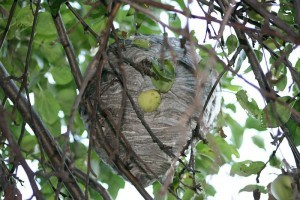
We couldn’t make the sale this year, so we grew our own
While I hated gardening as a kid (getting assigned weeding as your first plant related experience tends to do that), I’ve embraced it more and more as time has gone on. Last year, for example, I took on the enjoyable task of revamping and stocking my neighbor’s small flower garden across the street. This year, Beth and I agreed it was time to get a decent home greenhouse, so I looked around online and with son-in-law Russ’ help, have a really nice 8×6′ redwood frame greenhouse that’s full of seeds in containers ready to go.
When we moved to Hartland 13 years ago, one of my discoveries was the annual Fedco tree sale. Over the years, I have come to understand that it’s as much a cultural event as it is a great opportunity to get Maine hardy trees, vines, canes and organically grown set plants. The parking lot fills up early and quickly. Before it was moved to the current location, it was an adventure just to park as both sides of the rural road were lined with cars for half a mile in either direction. Since it moved to the present location (see link below) parking and access have gotten much easier.
http://www.fedcoseeds.com/trees/treesale.htm
It’s the kind of event where you see people you haven’t had a chance to chat with for ages, or get to know new and often interesting ones while waiting in line, learn about new varieties of fruits and discover ones you never knew grew in Maine. Several years ago, I bought twenty everbearing raspberry canes. They fruited the first year, doing so well I went back the next two years to get more. The third time, they were our of the red variety we liked, so I took a flier on Anne, a gold everbearing type that have turned into such a prolific producer we end up freezing much of the harvest and enjoy them in pancakes and ice cream smoothies all winter long.

Ultra sweet and big, big, big.
This year I’m going to be conservative. We have no more room for raspberries, but deer consumed one of the cherry trees I bought last year, so I’ll replace that and maybe add an apricot. The good news for you readers is that the sale is next Friday and Saturday, so that gives you time to take advantage of it. Here’s what Downeast Magazine said last year when they named the sale a Best Springtime tradition: “It’s just two days in late April or early May, but ever since 1984, the annual Fedco Tree Sale has been a red-letter event for Mainers with a green thumb. The Fedco warehouses just off I-95 in Clinton are filled with apple, peach, pear, plum, cherry, and nut tree saplings, plus blueberry bushes, rootstock, and vines, and close to 3,000 folks come from all over the state to shop and visit with friends they may not see again until the Common Ground Country Fair. It’s a rite of spring. 213 Hinckley Rd., Clinton. 207-426-9900. fedcoseeds.com”

So good you can have lunch while picking them come late July.
Hope to see some of you there, but if you want the best selection, go on Friday and browse the online catalog (http://www.fedcoseeds.com/trees/) in advance to create a wish list so you won’t be disappointed.
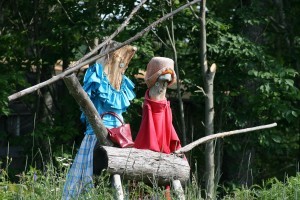
If you’re coming from the Eastport area, we’d love to hitch a ride.
Lea Wait's Blog
- Lea Wait's profile
- 509 followers




